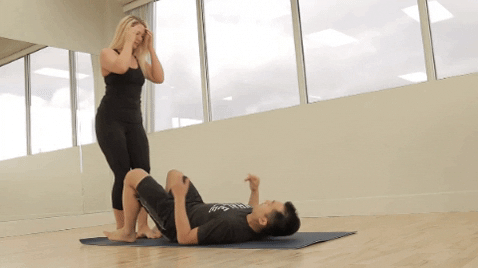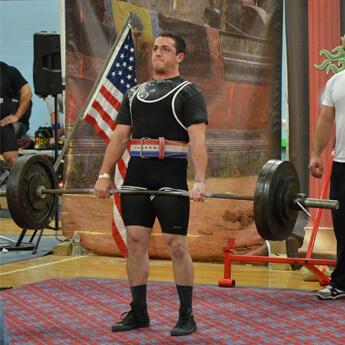33 Couples Yoga Poses to Take Your Relationship to the Next Level

From Instagram gurus, major publications, family and friends to your work colleagues, it is hard to go very long without hearing about yoga.
We get it. Yoga is a great form physical activity to reap the benefits of exercise. The thing is though, the majority of yoga practitioners partake in it as a form of individualistic practice. However, there is more to yoga than meets the “third” eye.
Couples yoga is a shared experience focused more on the connection with one another rather than just yourself. By engaging in couples yoga poses with your partner, you are accessing a whole new realm of benefits for both you as individuals and for your relationship together.
Unfortunately, it isn’t all that easy to understand how to do a lot of these partner yoga poses for two people properly. This is why we have put together a great list of couples yoga poses for beginners. We have also included poses that are more difficult to satisfy the needs of all my fellow experienced yoga practitioners.
Before we dig into these yoga poses for two love birds, what they are, and exactly how to do them, let’s explore just exactly how this shared endeavor can truly benefit you and your relationship.
4 benefits of couples yoga that will take your relationship to new heights
1) Couples yoga helps to “bring the sexy back” into your relationship
On its own, yoga has been shown to help increase your sex drive, sexual satisfaction, and sexual dysfunction for both males and females.
But doing yoga poses for couples produces a heightened sexual attraction between you and your significant other. One reason for this is that the feelings of arousal we get when we are “in the mood” or sexually attracted to someone is actually very similar to the arousal of physical exercise. Going through various partner yoga poses allows you to tap into this natural physical arousal that will have you being physically active in another way in no time.
If that wasn’t enough, add a little nude yoga to spice it up some more. It will help both of you to become more comfortable and confident with your bodies. All while carefully, yet playfully, interacting with the body of your significant other bringing you both to a heightened level of sexual connection with your partner.
2) Strengthening the core of your relationship: communication, understanding and trust
Mirroring, matching, or moving in synchronization with your partner is actually a form of mimicry. Doing this with your partner has been shown to not only help couples form a deeper bond but also to reach a new level of empathy and understanding of one another.
Just think about it, as you are moving from one pose to the next you have to:
- Communicate both verbally and non-verbally with each other
- Understand the wants, needs, and limits of your partner in particular poses by listening both to what they say and their body says to you
- Trust your partner to support you, work with you, be willing to slow down the pace for you or to push themselves to bring you a greater experience through the practice
- Be vulnerable with one another as you try new poses, acknowledge your weaknesses, and embrace each other’s strengths
These aren’t anything to scoff at. There is a reason why people like Dr. Brene Brown has written books and given Ted Talks on the years upon years of research she has done on these topics. They are the foundational core of any healthy and happy relationship. A core that can be developed more through the use of couples yoga.
3) Bring a new level of stability and calm to your relationship
A long list of studies has already demonstrated that yoga is great at reducing your levels of stress, anxiety, and depression. By doing couples yoga together, you are ensuring that both halves of this one relationship are improving their emotional and mental health.
Without all that external stress and anxiety, the smaller issues that may have typically sparked an argument, negative feelings, or resentment can be handled with greater ease and grace. When this negativity is diminished, it allows two of you to experience more positivity together.
In fact, just the process of holding each other’s hands is a powerful and immediate remedy of stress. Not just anyone’s hands though.
Connecting physically with each other by simple hand-holding helps to calm down and alleviate the neural and biochemical response to stress. This benefit is amplified when you go from a simple hand-holding to a continuous, synergistic movement of each other’s bodies through various partner yoga poses.
4) Improve overall relationship satisfaction by creating new experiences and memories together
Have you ever been stuck in a relationship rut? You know, when you get stuck in the same old routine? You don’t notice at first but weeks or months later you just realize things haven’t been as great as they used to be.
These little ruts can be remedied and avoided by simply making life more of an adventure, together. Taking on new challenges, like couples yoga, is a great way to bring new challenges and activities for you two to embark on together.
The new challenge of being an active and arousing one has been shown to increase the overall quality of the relationship as well as the romantic attraction to one another.
The best part about couples yoga, to address these issues, is that it is always a continuing challenge. There are always new poses, a variety of sequences, and opportunities to kick the difficulty up the notch just so the two of you can tag team and conquer it.
Don’t worry though, we aren’t going to have you flying through the air from the get-go. If you are a newbie, dive into the couples yoga poses for beginners that we have assembled to get your feet wet. As you find your groove, you can keep your practice extra challenging by:
- Extending the duration of your sessions
- Modifying the poses you are comfortable with to make them more challenging
- Spicing it up all together with brand new couples yoga poses from the intermediate and advanced couples yoga poses sections
33 Couples yoga poses for two that you have to try
18 Easy partner yoga poses for beginners
1) Back-to-back seated meditation
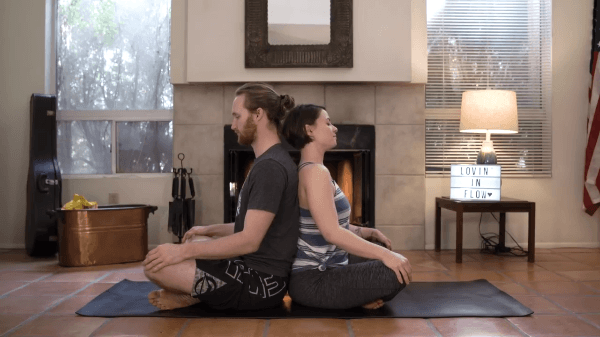
- Sit back-to-back with your partner with your legs crossed.
- Sit upright so your lower back to your shoulder blades are in contact with one another.
- Use each other’s back as a form of support to allow your core muscles to relax a bit more.
- Begin your meditation practice by breathing in rhythm with your partner.
- For breathing, feel free to utilize one of these two patterns:
1) Double Breath - You and your partner inhale simultaneously, feeling the pressure of the air push outward against each other. Then, exhale in tandem focusing your attention on the relaxing effect it has on not only yourself but of the body and energy of your partner.
2) Yin-yang - Bring balance to your combined breathing by exhaling as your partner inhales and inhaling as your partner exhales.
2) Seated side bend

- Sit back-to-back with your partner with your legs crossed.
- Raise your hands out to the sides making them parallel with the ground.
- Have your partner mirror you while either having your palms touching, holding one another’s forearm or interlocking hands.
- Begin the lean to one side by extending the opposite shoulder up and away from the hip. This will make the bend happen purely in your core and maintain proper form.
- As you bend, one set of hands will come in contact with the ground which you can use to stabilize you both.
- At this point, continue to deepen the bend while keeping your butt firmly planted on the ground and extending your opposite arm over your head for a deep stretch.
- As you begin to bend, place the hand of the side you are leaning to on the floor.
- Return back to center and repeat for the opposite side.
3) Seated spinal twist
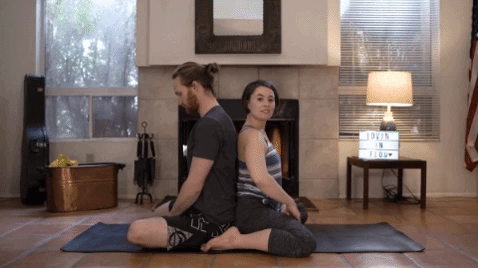
- Seated back-to-back with your legs crossed, inhale and extend your arms to the ceiling.
- As you exhale, begin twisting to the right as your partner twists to the left.
- Extend your right arm and bring your right hand to your partner’s left knee as they mirror you taking hold of your left knee.
- Stay in the twist position, breathe in rhythm with your partner, and use your hold on your partner’s knee to continually release and deepen the stretch.
- Return to center and repeat for the opposite side.
4) Facing twist
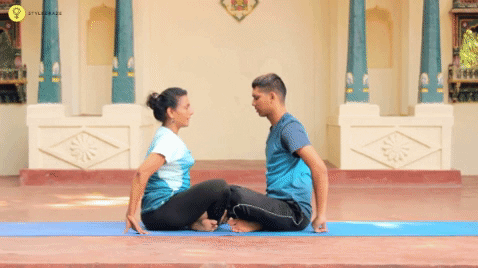
- Sit with your legs crossed, facing your partner with your knees touching.
- Extend your right hand towards their right waist.
- Stretch your left hand behind your back towards your right waist.
- Your partner mirrors your movement by setting up in the same way.
- Take hold of your partner’s right hand with your left hand.
- Take hold of your partner’s left hand with your right hand.
- With the twist begun, take turns deepening the stretch for each other by pulling on your partner’s hand behind their back.
- Be sure to keep your upper body upright throughout the movement while deepening the stretch to reduce any unnecessary strain on your body.
- After several breaths in this position, return to center, and repeat in the opposite direction.
5) Facing bound angle forward fold

- Start by sitting with your legs crossed, facing one another, and with enough space so that if you both reach out, you are able to grab onto each other’s wrists.
- Reach out and grab hold of each other’s hands/wrists/forearms.
- Start by slowly leaning backward to help pull your partner into a forward fold.
- As you deepen the fold of your partner, feel for the tension to know where their limits are.
- When your partner is deep into the stretch, allow them to sit in this position taking in deep, slow, and mindful breaths.
- On each inhale, your partner will rise slightly and as they exhale lean just a little bit further back to deepen their stretch.
- Repeat this for several breaths or until your partner is ready to return to center.
- Return to center and switch roles with your partner leaning backward as they bring you into a forward fold.
6) Boat pose
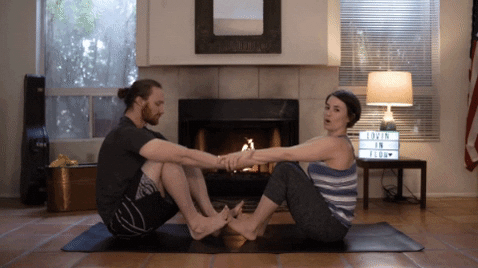
- Seated facing one another, bend your knees and touch toes with your partner.
- Extend your hands outward and take hold of their wrist or forearm.
- Bring the soles of your feet in contact with each other as you begin to raise your feet upward.
- During this process, your knees should come towards your chest as you keep the upper body straight.
- As your legs continue to rise, begin straightening your legs.
- Hold this final position for several breaths before slowly reversing the steps back to your beginning position.
7) Wide-legged boat pose
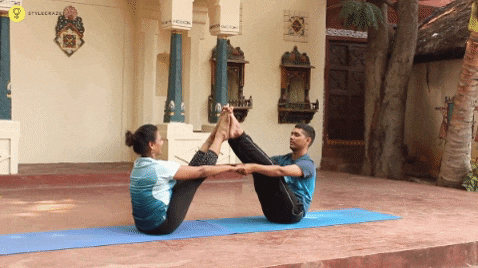
- Enter into a straight-legged boat pose.
- At the peak of the pose, let go of your partner’s hands one at a time.
- Re-grab your partner's hands but now in-between your legs.
- Once both hands are centered between your legs, slowly begin to switch your legs from a straight-legged boat pose into a wide-legged boat pose by pressing against each other’s soles as your legs move to the sides.
- Continue to move your legs outward as far as it is comfortable for you and your partner.
- Breath in this position for as long as it is comfortable for the both of you before returning to center.
8) Seated forward fold and backbend
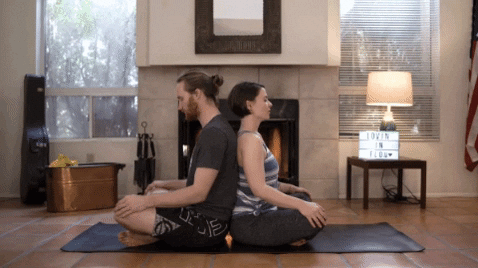
- Sitting back to back, start with your legs crossed.
- With the legs still crossed, raise your hands up with an inhale, and forward fold on your exhale.
- As you forward fold, your partner enters into the backbend laying along your back with arms extended over your head.
- To deepen your partner's backbend, reach up, take hold of their wrists, and provide a slight pull.
- After 10-15 breaths, return to center, and switch roles.
9) Wide-legged forward bend

- The wide-legged forward bend starts with you and your partner seated facing one another.
- Both partners spread their legs wide and have the soles of your feet touching.
- Your partner will begin by extending their arms upward and slowly folding forward.
- Towards the bottom of the fold, your partner will place their hands on your upper thighs which they can use as a support or deepen their fold.
- While they fold forward, you can place your hands on their shoulders or upper back to apply slight pressure to deepen your partners stretch.
- After several breaths in this position, return to center and switch roles.
10) Seated forward bend

- Much like the wide-legged forward bend, start by sitting facing each other but this time, with your legs straight forward, knees straight, and the soles of the feet touching.
- Taking grasp of your partner's hand, allow them to lean slightly back to pull you into a forward bend.
- Breath in this bottom position while feeling the tension in your legs from the stretch.
- Hold this position for several breaths, release, repeat, and then switch with your partner.
11) Standing shoulder opener
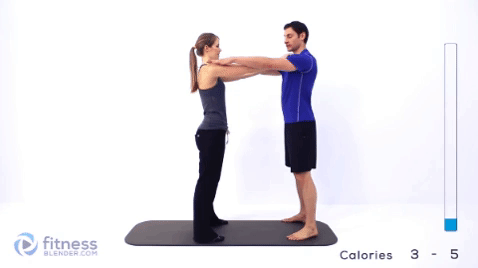
- Standing an arm's length away from your partner, place your hands on one another’s shoulders.
- Keep your legs and arms completely straight as you begin to take steps backward, away from each other.
- Each step will lead to a natural forward lean of the torso. Keep walking backward until your upper body is parallel with the ground.
- To begin opening up those shoulders, keep your hands firmly placed on your partner’s shoulders as you begin to drop your chest down.
- You can either have both of you lower your chest at the same time or focus on having a deeper stretch by having one person drop their chest a bit lower at a time
12) Chair pose

- Start by standing facing your partner.
- Take hold of each other's hands and step backward until you can not move further apart.
- Using the leverage of your other half, sit back into a squat position.
- Stay in this position, focusing on your breathing.
- Make sure that your knees stay behind your toes, shoulders over your hips, back straight, and looking straight towards each other.
- Hold this pose for several breaths before returning to center.
13) Standing forward fold

- Standing with your backs facing each other, leave a few inches of separation.
- Inhale while raising your arms towards the sky.
- As you exhale, progress to a forward fold by hinging at your hips.
- Bring your chest towards your legs so that your face is now facing your partner, upside down.
- From here, extend your arms towards each other.
- Based upon your flexibility you can either hold hands, forearms, elbows, or shoulders.
- Stay in this bottom position for several breaths until releasing.
- When coming back up, be sure to come up the same way you went down; hip hinge upward with your core engaged to make sure you do not add unneeded stress on your body.
14) Wide-legged forward fold

- Stand with your legs spread wide and backs together.
- Inhale, raising your arms towards the sky.
- As you exhale, progress to a forward fold by hinging at your hips.
- Bring your chest towards your legs so that your face is now facing your partner, upside down.
- From here, extend your arms between your legs and take hold of each other's forearms or wrists.
- Stay in this bottom position for several breaths until releasing.
- When coming back up, be sure to come up the same way you went down; hip hinge upward with your core engaged to make sure you do not add unneeded stress on your body.
15) Standing backbend

- Facing one another in a standing position, take hold of your partner’s forearms.
- With your core engaged, begin to move into a backbend by simply leaning away from each other, and using the leverage of your partner to maintain stability.
- Keep your shoulders back and head extended in order to produce a wonderful opening of the chest. as well
- When you are both ready to exit the pose, start by returning your head to a neutral position. Straighten out your back, and then return to standing.
16) Child's pose & fish

- This relaxing yet opening movement starts with you resting in a child’s pose.
- Your partner begins by lowering themselves down so that the entirety of their back is in contact with the entirety of yours.
- While laying on you, your partner then extends their arms over their heads.
- If flexible enough, they will reach out and take hold of your hands resting on the ground.
- Play around with the positioning of your legs and arms to get the full range of stretch and opening throughout your body.
- Focus on your breath and breath in synchronization with your partner, either matching each other’s breath or with yin-yang breathing.
- After breathing for 10-20 breaths, reset, and repeat in the opposite positions.
17) Final relaxation pose
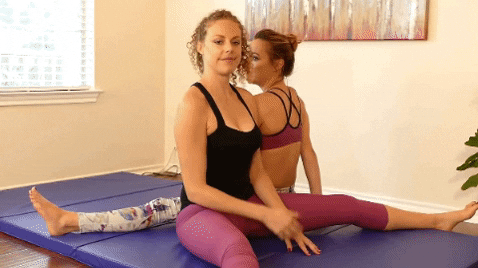
- Start seated side to side, facing in opposite directions, and legs spread wide.
- Take hold of each other’s inner hands (ones closest to each other).
- Support each other as you begin to twist your upper body slightly away from each other and begin leaning backward.
- This slight twist will align you with your partner’s upper thigh.
- Continue supporting each other until your mid-back comes in contact with your partner’s upper thigh
- Allow for a slight bend in the back as your upper body and head continue to lean back until they come in contact with the floor.
- Stay in this vulnerable pose, breathing, until you and your partner feel ready to bring your practice for the day to an end.
18) Front plank
- The base begins by laying on their back elevating their legs upwards so that their feet are above their hips.
- The flyer stands at an inch or two away from the glutes of the base.
- The base then prepares for the elevated portion of the pose by placing their feet on the hips of the flyer.
- You will have to bend the knees slightly to make contact with proper spacing.
- The flyer and base then hold their hands together.
- The flyer then leans into the feet of the base, placing their weight on them.
- While doing so, be sure to keep your body perfectly aligned and engaged.
- The base then takes the weight of the flyer, beginning to extend their legs.
- While keeping the arms straight, the weight of the flyer is transitioned directly above the base.
- The flyer keeps their core engaged and the base should have their feet directly above their hips.
- The flyer, when stable, pressed their hands against the hands of the base while pointing their toes outward and upward.
- In this plank position, inhale and exhale in a controlled fashion for several repetitions.
- Safely come down to the starting position in the reverse order.
11 Intermediate two person yoga poses
1) Assisted backbends with boat
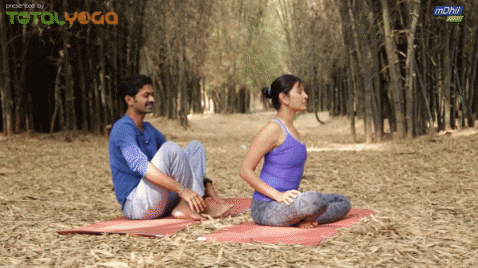
- Your partner begins seated with legs crossed or extended in front of themselves.
- Seated behind them, place your feet on the middle of their back.
- Your partner will reach back with their arms and you will grasp their forearms/wrists/hands.
- Start to slowly stretch your partner by pressing on their back with your feet and leaning away.
- These two movements in combination will produce a great opening of the chest, core, and shoulders.
- In this position, you can start to play around a bit by walking on their back, changing the positioning of the feet, or a variation of pressure being applied to the arms.
- Above all else, communicate with your partner as you progress throughout the movement.
- Make sure they are comfortable with each stage before moving to another one.
2) Bridge & supported shoulder stand

- Your partner starts by laying on their back.
- They start to enter into a bridge by planting their soles to the ground and driving their hips upward.
- With their elbows on the ground, they can support their own bridge by placing their hands on their hips if they need to.
- Laying with your glutes at your partner’s feet, raise your legs and place them on the upper shin of your partner.
- Grab onto the ankles of your partner and then drive your hips upward to enter into the shoulder stand.
- Holding this pose for several breaths, releasing your hips, and re-engaging is a great way to stretch your lower back, engage your core, and activate your glutes.
3) Head to knee side bend

- Begin by sitting with the sole of your right foot touching your inner thigh and left leg fully extended out wide.
- You partner will mirror you with their right foot touching their inner thigh and left leg fully extended out wide.
- Both of you position together by bringing shins of your folded legs together, making it so you are both slightly facing away from each other.
- Both of you hold hands with the arms on the same side of your extended legs.
- Raise the other hands up and over your heads, pressing your shoulders up and away from your hips to begin entering into a side bend.
- Using your connection at your hands for support, continue extending your arm up and over your head while the bend continues to deepen towards your extended foot.
- If flexible enough, reach out with your extended arm and take hold of your foot on your extended leg.
- Stay in this deep stretch for several breaths or until you feel comfortable.
- Return to center by reversing the movement and using your partner to help support you safely.
4) Double Camel
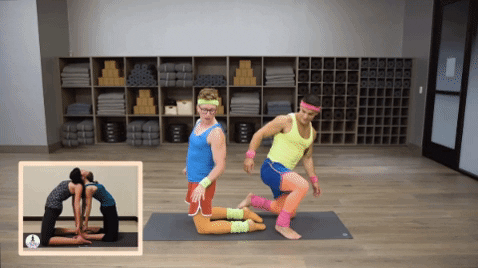
- Start on your knees with your backs facing each other.
- Align yourselves by placing one foot in between the feet of your partner.
- Once set up, engage your core, place your hands on your lower back for support, and begin to slowly enter into a backbend.
- Guide your heads back until you reach each other’s shoulders.
- Once comfortably supporting one another, you can begin to deepen the stretch by driving your hips forward and allowing your arms to hang beneath you.
5) Standing side-to-side triangle pose
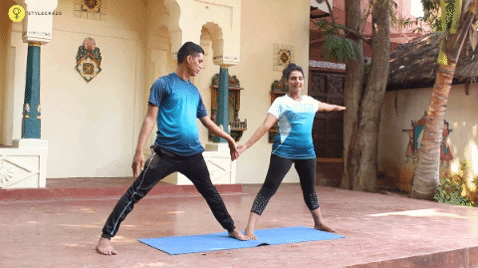
- Stand next to your partner, with your legs spread wide, and your inner feet next to each other.
- (Inner hands) Place the palm of your left hand and your partner’s right hand together in-between you.
- On a deep inhale, begin to enter into a side bend towards your partner by raising your outer hands, pressing your outer shoulder up and away from your outer hip.
- Continue this side bend pushing your connected inner hands down as you rise your outer hands up and over.
- Bring the palms of your outer hands together so that you and your partner are now almost touching each other's heads.
- Deepen the stretch with support from each other.
- Hold this pose for several breaths before returning to center.
6) Revolved Chair
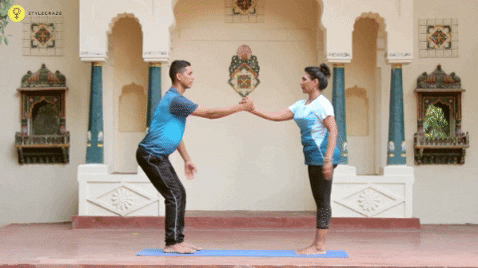
- Stand facing each other, take hold of your partner's right hand with your right and their left hand with your left.
- Sit back into the chair position leveraging one another’s weight to find balance.
- Begin to revolve by releasing your left hands, bringing them extended behind you.
- Rotate your torso so you are looking at your extended arm.
- Embrace this deep twist for a great opening of the core and chest.
- As you return to center, inhale, and exhale as you rotate to the opposite direction.
7) Sideways warrior

- Facing away from your partner and with your left feet next to your partners, enter into warrior 2 pose.
- From here, both of you lift your right hands up and over your head to take hold of one another’s hands.
- Make sure when reaching with your right hand to focus on stretching the right side of your torso rather than crunching to your left.
- Increase the difficulty by extending both your hands higher or do a slight tug and pull on each other to increase the stretch.
- Slowly exit out of the pose after holding it for several breaths and repeat on the opposite side.
8) Cobra with chair

- With your partner lying flat on the floor, stand over them with your feet place just outside their knees.
- Your partner will begin to arch their back while lifting their head and shoulders.
- While moving they begin to extend their arms behind them with the palms of their hands facing outward.
- As they reach out, take hold of your partner's hands
- With hands clasped, begin to squat and sit back into the chair pose.
- Take note that you can’t just leverage all of your weight with your partner as you would in regular chair pose.
- Stay firm and only provide a slight lean to stay within the limits of what your partner can handle.
9) Stacked planks
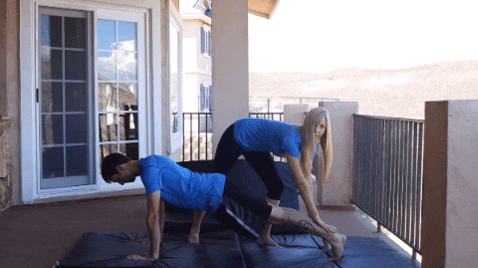
- Start by having your partner enter into a simple plank as if they are at the top of a push-up.
- Place your hands on the ankles or calves of your partner
- Enter into the stacked plank by raising and placing one leg on the upper back/shoulders of your partner at a time.
- Be sure to breathe throughout this pose as it is a serious workout for your core that will help improve your balance and conditioning.
10) Assisted King Pigeon

- Start by having one partner enter into the pigeon pose.
- They can do this by starting in downward dog, extending their right leg away from you before pulling it through to the front of the mat.
- As you pull it forward, be sure to tuck your shin underneath you so that your knee will be by fingers of your right hand and your foot is tucked behind the wrist of your left hand.
- Sit in this position and extend your left leg and toes away from you
- As your partner is coming into pigeon pose, you are standing behind them.
- Take your partner’s extended foot and elevate it to create a bend in their knee.
- Place their foot in between your knees to hold it in place.
- As your partner raises their arms over their head, support them by holding their arms at their elbows.
- Help your partner to complete the pose by slightly pulling on their arms backward.
- With the complexity of this movement, be sure to tune into your partner’s limitations and to stop before they reach their limitation to avoid injury.
- Stay in this final pose for several breaths and slowly return to center one body part at a time by lowering your arms back down and bringing the extended foot back to the ground.
11) Lifted plank
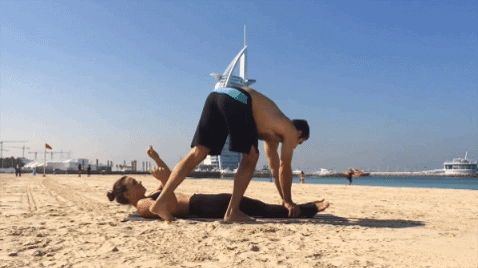
- The base starts by simply laying firmly on the ground.
- The flyer enters into a plank pose placing their feet by the top of the head and arms around the knees of the base.
- Before elevating, your core should be engaged and your body should be straight and tight.
- When ready, the base will then use their hands to press the flyer's legs up into the air.
- Changing the position of the hands or doing push-ups are a great way to have fun in this pose with your partner.
4 Advanced couples acro yoga poses
1) High-flying whale

- Start by having the base laying on the ground on their back.
- The flyer will stand with their heels touching the base’s shoulders.
- The base grabs onto the lower calf/ankles.
- Then the base rises their legs up and back towards the flyer.
- As the flyer leans back into your feet, the base lines up their heels to be centered on the shoulder blades.
- To ensure this first step happens smoothly, the flyer should take hold of the bases ankles as they lean back into them.
- As the flyer continues to lean back, the base extends their legs and takes the weight of the flyer as they start to leave the ground
- Move your legs and arms to center the flyer over your body.
- Once elevated over the base, the flyer can arch the back, drop the head, and extend the arms to hang out to the sides.
- Stay in this pose for several deep breaths to engage in a deep stretch of the upper back, opening the chest, and lengthening of the shoulders.
- Come out of the pose slowly before switching roles.
2) Front bird pose
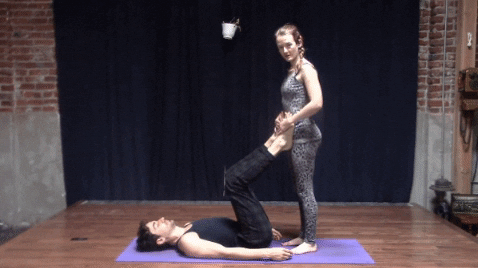
- The front bird pose is a more advanced variation of the front plank.
- Enter into a front plank.
- The flyer focuses on balancing themselves, releasing hold of the bases hands, and extending them up and outwards (think wings of a bird!)
- Be sure to let go of each other hands while gradually reducing the level of support the hands provide to find a balanced state before fully letting go.
- With legs extended, arms reaching out, engage your core and open your chest in front of you by creating a slight bend in the back.
- When returning to center simply reverse the steps slowly and switch roles with your partner.
3) Lifted Locust
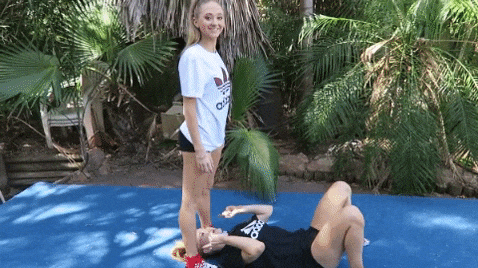
- Similarly to the lifted plank, the lifted locust follows the same steps for setting up.
- This time, the base places their hands on the knees of the flyer.
- The base elevates the flyer into the plank position where the flyer then slowly enters into an elevated backbend.
- While lowering, the flyer starts to curl the feet in towards their head entering into the final stage of the lifted locust.
- Hold this pose for a few breaths and then carefully return into the plank pose, lowering the legs, and then releasing the backbend.
- You can repeat this step several times or simply have the base lower you to finish.
4) Acro star pose

- Start with the base laying on their back.
- The flyer then stands by the head of the base.
- Begin by taking hold of one another’s hands while the base raises their feet with the soles of their feet facing upward.
- The flyer starts to lean over the base, holding on to the ankles of the base, until the flyer’s shoulders are resting on the feet of the base.
- The next steps all have to happen simultaneously and is really difficult (having a spotter is always a good idea).
- To get into the Star Pose from here, the base will begin to press their feet and hips upwards to provide a stable, vertical base for the flyer.
- While this is happening, the flyer is shifting their weight on to the base.
- As the flyer begins to shift over the base, they engage their core, glutes, quads, calves, and toes to be fully extended into a plank with toes facing towards the sky.
- It should end with the flyer and legs of the base forming an almost straight line while using each other’s hands to maintain balance.
